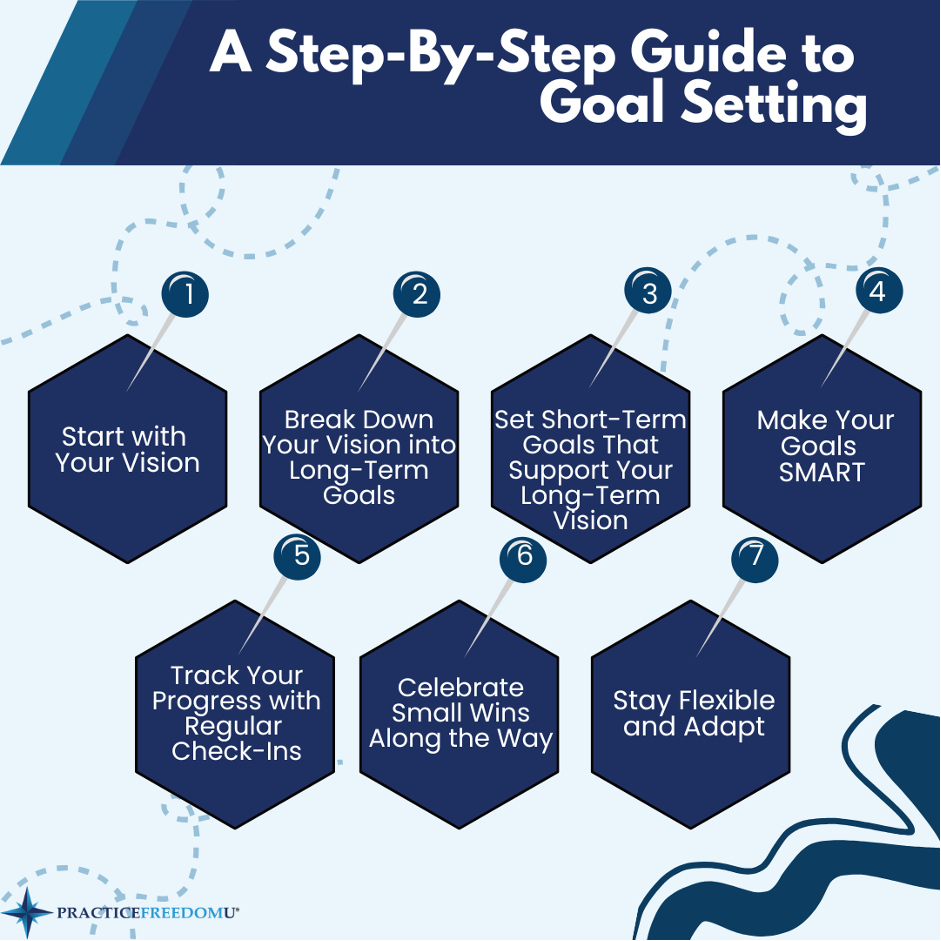As a private practice owner, you wear many hats and often juggle an overwhelming number of tasks. From treating patients to managing finances, handling staff, and overseeing operations, it’s no wonder many practice owners feel they’re constantly putting out fires instead of moving forward with intention.
This is where the art and science of setting goals come in. While many in the healthcare industry consider goal-setting as something “nice to have,” it’s actually essential to growth and long-term success. Setting effective goals for your physical therapy practice can transform not only your business but also your sense of fulfillment and purpose as a practice owner.
In this article, I’ll walk you through practical, actionable steps to establish meaningful goals that align with your vision. Whether you’re setting out to achieve a small milestone or targeting a big leap in your practice’s growth, the right approach can help you stay focused and make significant strides forward.
Why Goal-Setting is Crucial for Private Practice Success
At its core, goal-setting is a blueprint for success. Without clear goals, it’s easy to fall into the trap of “busy work”—focusing on tasks that keep you active but don’t move the needle on what really matters to your practice. Goals give you clarity on what’s important, helping you prioritize your time and energy on actions that have a lasting impact. (The National Society of Leadership and Success)
Moreover, setting goals helps create a structured framework for everyone in your practice, from your front desk staff to your therapists. When everyone is aligned around shared goals, your team can work more effectively toward common outcomes, fostering a culture of collaboration and accountability.

A Step-By-Step Guide to Goal Setting
Before diving into specific goals, it’s important to clarify your vision for the practice. Ask yourself:
- What kind of impact do I want to make in my community?
- What reputation do I want my practice to have?
- What work-life balance do I want to create for myself and my staff?
A vision is more than a list of desired outcomes; it’s your “why.” It’s what drives you and inspires you to build the practice of your dreams. Take the time to get clear on this vision—write it down, share it with your team, and revisit it regularly. (Entrepreneur)
Step 2: Break Down Your Vision into Long-Term Goals
Once you have a clear vision, translate it into long-term goals. These are typically goals that span over 3-5 years and serve as milestones toward realizing your vision. Think about your growth, profitability, patient experience, and team culture when setting these.
For instance, if your vision is to become the most trusted physical therapy provider in your area, a long-term goal might be to increase your practice’s market share by 20% within five years. Or, if you aspire to build a practice that fosters a work-life balance, a goal could be to implement flexible scheduling for staff within the next three years.
Examples of Long-Term Goals:
- Increase patient retention rates by 25% over the next three years.
- Hire two additional therapists to accommodate growth within the next five years.
- Enhance your online presence to drive 50% of new patient inquiries through digital channels by 2027.
Long-term goals like these provide a sense of direction and inspire you to dream big.
Step 3: Set Short-Term Goals That Support Your Long-Term Vision
After establishing your long-term goals, identify short-term goals that serve as stepping stones. Short-term goals are typically achievable within a year or less and bring you closer to your larger objectives.
The key is to make your short-term goals specific, measurable, and actionable. For instance, if one of your long-term goals is to increase patient retention, your short-term goal might be to improve the patient onboarding process within six months. This smaller, actionable step directly contributes to your bigger picture and sets you up for success.
Examples of Short-Term Goals:
- Streamline the patient intake process by reducing wait time to under 10 minutes.
- Train staff on new techniques for enhancing patient communication within the next three months.
- Implement a follow-up system to check in with patients post-treatment within the next six months.
By creating these bite-sized, actionable goals, you and your team can focus on tangible progress rather than feeling overwhelmed by a distant goal.
Step 4: Make Your Goals SMART
A popular framework for setting effective goals is the SMART model. This stands for Specific, Measurable, Achievable, Relevant, and Time-bound. Let’s break it down with an example:
Goal: Increase patient referrals by 15% over the next six months.
- Specific: “Increase patient referrals” is precise and actionable.
- Measurable: “By 15%” adds a quantifiable target.
- Achievable: Based on your current patient base, a 15% increase may be realistic.
- Relevant: Referrals directly impact practice growth, aligning with your vision.
- Time-bound: The six-month timeframe gives you a clear deadline.
Using the SMART criteria helps ensure that your goals are not only well-defined but also attainable within a realistic timeframe. (Forbes)
Step 5: Track Your Progress with Regular Check-Ins
Setting goals is only the first step—tracking and assessing your progress is what ultimately leads to success. Create a schedule for regular check-ins, whether weekly, monthly, or quarterly. These meetings provide an opportunity to review what’s working, adjust your strategies if needed, and keep your team motivated.
For instance, if you’re aiming to boost patient satisfaction scores by 10% within six months, establish checkpoints to gauge progress along the way. Ask for feedback from both patients and staff, and don’t be afraid to tweak your approach based on what you’re seeing.
Tracking progress also helps identify potential roadblocks early, giving you time to course-correct before small issues become major obstacles.
Step 6: Celebrate Small Wins Along the Way
Goal-setting can be a challenging process, and it’s important to celebrate small wins along the journey. Recognizing and celebrating progress—no matter how minor—can boost morale, reinforce positive behaviors, and remind you and your team of the progress you’re making.
For instance, if your goal is to improve patient retention and you start to see even a slight increase in repeat visits, take a moment to acknowledge this achievement. Celebrations can be as simple as a team lunch, a shoutout in a team meeting, or a personal “thank you” to staff members who are contributing to the goal.
Celebrating wins, big or small, is vital for maintaining momentum and keeping your team engaged and motivated.
Step 7: Stay Flexible and Adapt
It’s important to remember that goals are not set in stone. Circumstances change, the market evolves, and sometimes you need to pivot. While it’s crucial to stay committed, it’s also essential to remain flexible. If certain goals no longer align with your practice’s vision or become unrealistic, don’t be afraid to adjust them.
This flexibility allows you to continue progressing without being tied to goals that may no longer serve you. Regularly revisit and reassess your goals to ensure they still align with your vision and the ever-changing landscape of healthcare.
As you work towards setting and achieving meaningful goals, it’s essential to keep in mind the broader vision of practice freedom. Practice freedom is about designing a business that works for you—giving you control over your time, energy, and resources rather than being constantly bogged down by daily operations. By setting specific, achievable goals and aligning them with your vision, you’re taking steps toward creating a practice that doesn’t just survive but thrives independently. Practice freedom means you can choose to focus on what you love, whether it’s patient care, new business opportunities, or spending more time outside of work with family and friends. It’s the reward for building a practice that aligns with your values, operates efficiently, and ultimately empowers you to live life on your terms.
This overarching goal of practice freedom is often overlooked but is the true north for many successful practice owners. Keep it in sight as you work through your goals, and let it be a motivator for achieving the milestones that bring you closer to a life of balance and fulfillment.
Setting goals is about much more than hitting numbers—it’s about creating a practice that reflects your values and vision. With a well-defined goal-setting strategy, you can break free from the day-to-day grind and start working on your practice instead of just in it.
Remember, this journey isn’t a sprint; it’s a marathon. Start with small, manageable steps that keep you moving forward, celebrate every milestone, and remain adaptable as your practice grows and evolves.
By setting meaningful goals and consistently working towards them, you’ll not only elevate your practice but also create a fulfilling and sustainable career for yourself. And in the end, that’s what true success is all about.
Goal-setting isn’t just about numbers on a page—it’s about purpose. Define it, break it down, stay consistent, and watch as those small milestones lead to big achievements in your practice and life.
————————————————————-
Are you ready for a coach? Join the hundreds of physical therapy owners who are building the practice of their dreams with the support, guidance and direction of a Practice Freedom U Coach. Take the first step towards creating a business that sets you free by scheduling a Discovery Call



